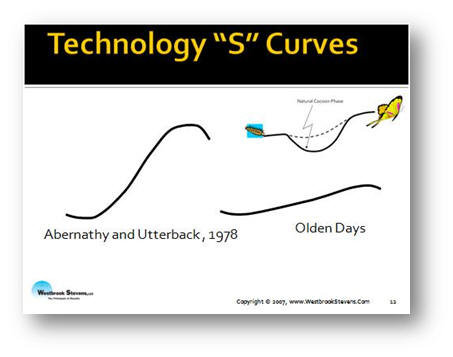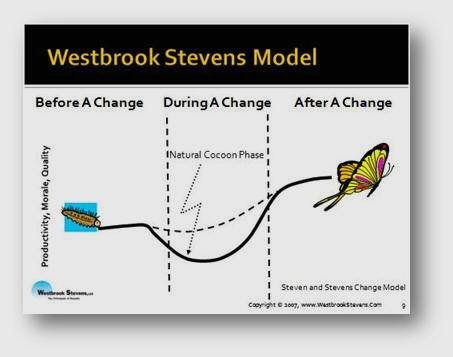Dynamic Environment
Organizations operate in a dynamically changing environment. The changes can be organized or chaotic. Kurkato (2007) argues that an organic structure works with an emphasis on the integration and coordination of organizational entities to achieve an organization’s goals and objectives in a turbulent or dynamic environment.
Simple and complex organizations fall into decentralized organic and centralized organic structures. Coordination of activities includes “direct supervision, standardization of work processes, standardization of outputs, standardization of skills and mutual adjustment” (Clayton, Fisher, Bateman, Brown &Harris 2005).
Therefore a structural approach in aligning an organization strategy to an evolving and unstable or turbulent environment remains a key component, as identified in the Abernathy/Utterback model.
While previous organizations remained static and had no innovative strategies to operate in such environments, organic organizations were characterized by decentralized approaches to organizational structures and management with identifiable and distinct levels of complexity.
Organizational strategy was projected on controls and formalization of tasks. However, measures were put in place to ensure organizations did not become wholly mechanistic, a trend that could evolve as organizations evolved.
Clayton, Fisher, Bateman, Brown and Harris (2005) identify various elements in the change and evolution process within an organization. According to Kurkato (2007), organic organizations rely upon employee initiatives and innovation in task performance.
Kurkato (2007) argues that in an organic organization, employee tasks are not well defined and problem solutions are a prerequisite of an individual. This also depends on a variety of structures with different characteristics. These include simple structures, functional structures, divisional structures, professional bureaucracies, innovative organizations, and matrix structures.
According to Kurkato (2007), the Abernathy/Utterback Model characterizes the change process in organic organizations where the first phase, also referred to as the fluid phase, is marked with a turbulent market, characterized with product innovation to fit the changing trends in a changing market.
Innovation and change in a dynamic environment place emphasis on individual skills and abilities in task execution. According to the model employees in an organic organization identify available opportunities and execute them according to their abilities and skills.
The fluid phase of the organization is marked with a lack of standards, procedures, and well-defined policies in aligning an organization to changing market and product trends. The operational environment is characterized by fluid and flexible approaches to product innovation, while competition remains low with little or no direct competition.
Change in Technology
According to the Abernathy/Utterback Model changes in technology and approaches to organizational evolutions rely on managers as change agents. However, approaches to organizational change vary depending on the type of organization and stage of evolution.
Entrepreneurial organizations are characterized by centralized management and lack of standardized task execution. However, such organizational structures are more suited for small industries and organizations. Leadership solves problems on a one on one basis.

Overcoming Mechanistic Drift
According to the Abernathy/Utterback Model the transition stage for an industry is characterized by architectural approaches to product innovation. Products are mass produced.
The strategy at this stage is to gain a competitive edge on competitors and market dominance. Kuratko, D.J. (2007), this stage is characterised by a formal organizational structure with mechanistic and rigid processes. Kuratko (2007) argues that organizations at this stage are characterized by task specification, and specialization and an inherent mechanistic characteristic drift.
A company starts to gain a broader market base while product innovation, with the objective of dominating the market, remains the key strategy and dominant factor. At this stage tests are done on an organization’s design to ensure alignments to its strategy. These tests include fit tests which examines issues of a marketing strategy, corporate-level activities, organizational responsibilities, and constraints.
These ensure an organization remains in track and keeps it from drifting into a mechanistic organization. In addition to that, these tests are valuable measure in preventing organizations from mechanizing themselves. Organizational executives continuously apply other tests such as good design tests which help align it to its culture, flexibility and efficient communication.
Organizational executives continuously design and introduce new changes appropriate with new trends in the operating environment. At this stage, industries do not introduce new products, but maintain original products but with characteristics and features which apparently remain the same across a company’s similar product range. Kuratko, D.J. (2007) argues that Abernathy/Utterback model emphasizes on dominance where monopoly and intellectual property rights act as sources of revenue for an organization.
While standards are not rigid, product development focuses on product enhancements and market domination. An Industry like Microsoft used its dominant position in the market to competitively stay and gain a strong position in the market when it introduced operating systems with graphical user interfaces that were user-friendly and which were tailored to dominantly address user needs.
Decision making in an entrepreneurial organization follows structures that are not formal but which are highly dependent on interactive approaches with a critical emphasis on the available opportunities and competitive threats. Asserts that “as environments become more dynamic, threatening and complex, organizations find competitive survival forces them to become more entrepreneurial” (Kuratko 2007)
As organizations continue to evolve, organizational executives continuously create standards against which they apply tests of compliance for their organizations (Elsevier 2010). The ability of an organization to design products and services to meet people’s needs are a vital aspect in identifying and determining whether a product meets and reflects the people’s strengths in terms of supporting them.
In addition to that, other tests include feasibility tests which are designed to identify bottlenecks that impede an organization in meeting people’s needs. Other tests include specialized culture tests, redundancy hierarchy tests and the accountability tests.
The Abernathy/Utterback model organizations evolve and reach a specific phase with an emphasis on product performance and cost-benefit analysis. At this phase, the company specializes on standardized products. Incremental integration of quality and value addition are important elements at this stage. Competition remains oligopolistic, while threats from competitors continually disrupt product innovations.
Other Models
Deducing from the above models and illustrations, other models tend to concur on the observed change in organizational structure. One of the comparisons is based on the Westbrook Stevens model, which constitutes three phases of organizational evolution.
The model identifies distinctive features in an organization’s structure before a change is introduced, during a change, and after a change. A critical analysis identifies all changes in the Abernathy/Utterback model as inherent in the Westbrook Stevens Model. These elements include dynamism, organizational hierarchies, the environment, and product innovation.

The above model illustrates the different phases through which an organization evolves and offers a comparative analysis to the Abernathy/Utterback model.
References
Clayton, B. Fisher, T. Bateman, A. Brown, M. & Roger Harris, R. (2005). Organizational Culture and Structure. Web.
Elsevier, B. V. (2010). Journal of Economic Behavior & Organization. Volumes 74.
Kuratko, D. F. (2007) Structuring the Company for entrepreneurship. Web.